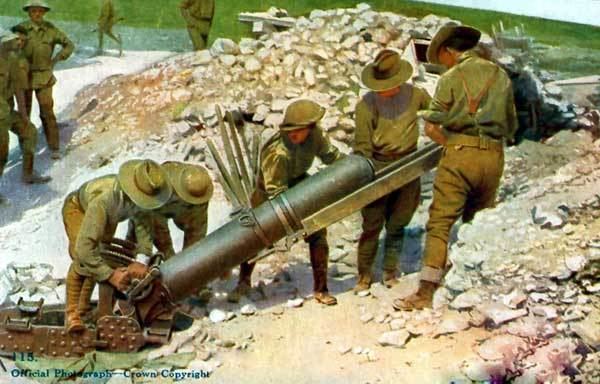Type Heavy trench mortar In service 1916–1918 Wars World War I | Place of origin France Used by United Kingdom
Austria Designer Dumezil-Batignolles | |
 | ||
The ML 9.45 inch Heavy Trench Mortar, nicknamed the Flying Pig, was a large calibre mortar of World War I and the standard British heavy mortar from the autumn of 1916. It was a modification of an original French design, the Mortier de 240 mm developed by Batignolles Company of Paris and introduced in 1915. Britain manufactured the modified version under licence.
Contents
History
The British ML 9.45-inch (240 mm) mortar was a design based on the French 240 mm mortar in 1915 and introduced in 1916. The British version differed from the French LT weapon in that the propellant charge was loaded through the muzzle whereas the French 240 mm had the charge loaded through the breech in a brass cartridge case.
In June 1916, following unsatisfactory trials with the French model, Britain replaced them with 30 of its own model, firing a 150-pound bomb, followed by 200 more in December 1916.
The Mark I with 51-inch (1,300 mm) barrel was introduced from June 1916. In 1917, the Mark II and Mark III followed with 69-inch (1,800 mm) barrel, and small numbers of Mark IV.
Combat use
It was operated by crews of the Royal Garrison Artillery which was the part of the British Army that operated the heaviest artillery weapons, formed into batteries of 4 mortars attached to each division, designated "V/nn" where nn = division number. From February 1918 they were reorganised and moved from divisional to corps control.
The weapon was dismantled for transport, requiring 4 carts for the barrel, base, carriage and ammunition.
In action, a heavy timber platform was constructed embedded in the ground, on which the mortar base was immovably secured. The mortar carriage sat on the base and could traverse. The mortar barrel and breech were mounted on the carriage which provided elevation.
They were used in the "siege warfare" on the Western Front to destroy enemy strongpoints, bunkers and similar "hard" targets which were invulnerable to lighter mortars and field guns. The US Army handbook described it : "... the use for which it is primarily adapted is in the bombardment of strongly protected targets - dwellings, covered shelters, command posts, entrances to galleries, etc - or in the destruction of sectors of trenches, salients and the like.". Their effectiveness decreased late in the war as German policy changed to a lightly held front line, hence decreasing available targets, and they became redundant when the war of movement resumed late in 1918.
Both the propellant charge appropriate for the required range and the bomb were loaded via the muzzle. Usually a Lee–Enfield rifle's bolt action mechanism was screwed into the breech. A special blank rifle cartridge was loaded and was triggered by pulling a lanyard, and fired into an igniter at the base of the mortar chamber, igniting the propellant charge and launching the bomb.
